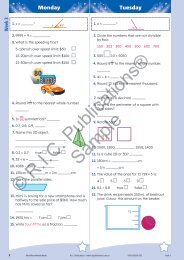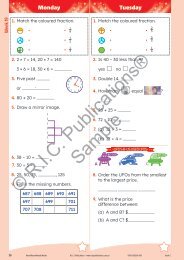RIC-20790_Teaching_Strategies_for_Writing_BkB_word_choices
Create successful ePaper yourself
Turn your PDF publications into a flip-book with our unique Google optimized e-Paper software.
TEACHING STRATEGIES FOR WRITING (Book B)<br />
TEACHING STRATEGIES FOR WRITING (Book B)<br />
TEACHING STRATEGIES FOR WRITING (Book B)<br />
978-1-925698-36-7<br />
978-1-925698-36-7<br />
978-1-925698-36-7<br />
TEACHING STRATEGIES FOR WRITING (Book B)<br />
TEACHING STRATEGIES FOR WRITING (Book B)<br />
TEACHING STRATEGIES FOR WRITING (Book B)<br />
TEACHER NOTES<br />
Sample open pages<br />
TEACHER INFORMATION<br />
TEACHER INFORMATION<br />
UNIT 1<br />
NOUNS, NOUN GROUPS<br />
AND ADJECTIVES<br />
UNIT 1<br />
NOUNS, NOUN GROUPS<br />
AND ADJECTIVES<br />
Focus<br />
Word <strong>choices</strong> – nouns, noun groups and adjectives<br />
Progression<br />
Recognise<br />
Students will recognise a noun/noun group/adjective from<br />
modelled examples.<br />
Choose<br />
Students will choose in<strong>for</strong>mative nouns/noun groups/adjectives<br />
from given examples, with teacher support.<br />
Use<br />
Students will choose and use appropriate, in<strong>for</strong>mative nouns/noun<br />
groups/adjectives in supplied and self-written sentences.<br />
Definition of terms<br />
Nouns are <strong>word</strong>s used to name people, places, things, feelings and<br />
ideas.<br />
A noun group is a noun with other <strong>word</strong>s used to name people,<br />
places, things, feelings and ideas.<br />
Adjectives are describing <strong>word</strong>s adding to or changing the<br />
meaning of a noun or pronoun.<br />
Introduction<br />
Good writers improve their writing by their choice of <strong>word</strong>s used<br />
to correctly name people, places, things, feelings and ideas. They<br />
can choose <strong>word</strong>s to add in<strong>for</strong>mation to nouns to make a more<br />
precise noun group. Noun groups have a noun, plus:<br />
• a determiner; e.g. the fish, many chips<br />
• a possessive; e.g. the boy’s pasta, Dad’s food<br />
• an adjective; e.g. tasty meal, sun-dried tomatoes<br />
LESSON NOTES AND PLANS<br />
Introduction<br />
• Discuss the text title and layout with students.<br />
• Do they think the text will be an imaginative story or will it be giving<br />
them in<strong>for</strong>mation?<br />
• Why do they think this? What are some of the features of in<strong>for</strong>mative<br />
text?<br />
• What is the purpose of the illustrations?<br />
• List foods they like to eat. Do they know which country their favourite<br />
food is from?<br />
• Introduce the term ‘noun’ and explain that the <strong>word</strong>s naming different<br />
foods are nouns.<br />
• Read the text with or to the class.<br />
• Identify some of the nouns used in the text to name foods.<br />
• Identify nouns used to name people places and things.<br />
• Identify nouns with capital letters. What do these nouns name? Why<br />
do these nouns have capital letters?<br />
Nouns – Page 5<br />
• Read and discuss the definition at the top of the page.<br />
• Explain that the text is divided into paragraphs with subheadings<br />
which have been numbered so it will be easier to find <strong>word</strong>s.<br />
• Discuss why nouns are an important part of every sentence and why<br />
it is important <strong>for</strong> writers to think about nouns and to choose good,<br />
interesting and in<strong>for</strong>mative nouns.<br />
• Explain that good writers think about different <strong>word</strong>s to name the<br />
same thing (synonyms) be<strong>for</strong>e choosing the best one.<br />
• Work through the activities with the class as a whole, ensuring they<br />
understand what is required of them.<br />
• Work with those requiring additional assistance while the remainder<br />
of the class work independently on the activities.<br />
Noun groups – Page 6<br />
ANSWERS<br />
Nouns – Page 5<br />
1. (a) people<br />
(b) honey<br />
(c) drink<br />
(d) Aztecs<br />
2. (a) damper<br />
(b) sandwich<br />
(c) chocolate<br />
(d) pasta<br />
3. Teacher check<br />
Noun groups – Page 6<br />
1. (a) thick dough<br />
(b) most popular food<br />
(c) more than a thousand years<br />
2.–3. Teacher check<br />
4. Answers may include:<br />
sun-dried tomatoes, Australian bread, a heavy iron camp oven<br />
5. Teacher check<br />
Adjectives – Page 7<br />
1. Teacher check<br />
2. (a) solid<br />
(b) ancient<br />
(c) Swiss<br />
3.–5. Teacher check<br />
ASSESSMENT ANSWERS<br />
Assessment activity – Page 26<br />
1. (a) sandwich<br />
(b) Chocolate<br />
(c) flour<br />
(d) pasta<br />
2. Teacher check<br />
3. their most popular food<br />
4.–6. Teacher check<br />
Class record sheet – Page vi<br />
ASSESSMENT WRITING<br />
• Paragraph topic – My country’s most popular food<br />
• Focus: Word <strong>choices</strong> – nouns, noun groups and adjectives<br />
Self-evaluation – Page xiii<br />
• nouns; e.g. kitchen benches, camp oven<br />
• Read and discuss the definition at the top of the page.<br />
• a number; e.g. five tomatoes<br />
• Explain that often instead of using one <strong>word</strong> to name something,<br />
good writers add more in<strong>for</strong>mation by writing a group of <strong>word</strong>s.<br />
• Provide examples of noun groups including the <strong>word</strong> ‘book’ plus<br />
a determiner—e.g. my book, this book, some books—and with<br />
adjectives; e.g. a scary book.<br />
• Show by example how careful choice of noun groups can lead to a<br />
clearer understanding by the reader. (For example, The boy ran home<br />
vs The small, terrified boy ran home.)<br />
Adjectives – Page 7<br />
• Read and discuss the definition at the top of the page.<br />
• Brainstorm adjectives to describe food using their sense of<br />
taste, smell, hearing and touch. This will assist them to complete<br />
Question 5.<br />
• Provide opportunities to share their answers to Question 5.<br />
2 978-1-925698-36-7<br />
www.ricpublications.com.au<br />
www.ricpublications.com.au<br />
3<br />
Teacher page 1 Teacher page 2<br />
UNIT 1<br />
WORLD FOODS<br />
Chocolate<br />
1. Chocolate came from ancient Central America. The<br />
Aztecs there made a drink from cocoa beans. But<br />
it tasted very bitter and was frothy. When chocolate<br />
was taken to Europe, people added sugar and honey.<br />
This made it sweeter to drink. It wasn’t until the 1800s<br />
that solid chocolate appeared. Now Swiss people eat<br />
chocolate more than any other people in the whole of<br />
Europe and the world.<br />
Sandwiches<br />
2. The sandwich gets its name from a British earl. Once, back in the 1700s,<br />
the Earl of Sandwich, who was busy playing cards, didn’t want to leave the<br />
table to eat. So he ordered a servant to put some meat<br />
between two slices of bread—and the sandwich was<br />
named. Although people had eaten food between<br />
bread, it didn’t have a name be<strong>for</strong>e this happened.<br />
Damper<br />
3. Damper is an Australian bread. It was made by stockmen or drovers<br />
using just flour, salt and water. It was easy to make and very filling. The<br />
ingredients they needed kept <strong>for</strong> a long time without<br />
spoiling. Today, campers still make damper, usually<br />
in a heavy iron camp oven. They also can add more<br />
ingredients to make it tastier, like cheese, chives,<br />
butter, milk and sun-dried tomatoes.<br />
Pasta<br />
4. Pasta, the most popular food in Italy today, was probably invented in a<br />
part of Italy called Sicily more than a thousand years ago! This popular<br />
food is easy to cook and is very filling. Pasta is made<br />
from flour and water, mixed into a thick dough. It is<br />
shaped into different types of pasta and dried. Today,<br />
there are about 350 different types of pasta, all with<br />
different names. For example, ‘spaghetti’ means ‘little<br />
strings’, while ‘orecchiette’ means ‘little ears’ and<br />
‘linguini’ means ‘little tongues’.<br />
UNIT 1<br />
NOUNS<br />
Nouns are naming <strong>word</strong>s <strong>for</strong> people, places and things.<br />
For example: servants, Italy, chocolate<br />
Good writers choose their nouns carefully.<br />
1. Which noun in Paragraph 1 means:<br />
(a) men, women and children<br />
(b) something made by bees<br />
(c) a liquid<br />
(d) people from a country<br />
in Central America<br />
2. Choose the best noun <strong>for</strong> each sentence.<br />
damper pasta sandwich chocolate<br />
(a) The campers cooked some<br />
over an open fire.<br />
(b) I like to put cheese and tomato in a .<br />
(c) Ice cream tastes great with<br />
topping.<br />
(d) My favourite Italian food is .<br />
3. Write an interesting sentence <strong>for</strong> each noun.<br />
(a) drovers<br />
(b) oven<br />
(c) ingredient<br />
(d) table<br />
(e) cheese<br />
4 978-1-925698-36-7<br />
www.ricpublications.com.au<br />
www.ricpublications.com.au<br />
Activity page 1 Activity page 2<br />
5<br />
UNIT 1<br />
NOUN GROUPS<br />
A noun group is a noun with other <strong>word</strong>s which add more<br />
in<strong>for</strong>mation about the noun.<br />
For example: cold, white, frothy milk; some milk; my milk.<br />
Good writers use in<strong>for</strong>mative noun groups.<br />
1. Write the whole noun group from Paragraph 4.<br />
(a) dough<br />
(b) food<br />
(c) years<br />
2. Add some <strong>word</strong>s to each noun to make an in<strong>for</strong>mative noun group.<br />
(a) butter<br />
(b) bread<br />
(c) meat<br />
(d) sandwich<br />
3. Write an interesting sentence using one of the noun groups from Question 2.<br />
UNIT 1<br />
ADJECTIVES<br />
Adjectives are describing <strong>word</strong>s. They can tell more about a noun.<br />
For example: a delicious, tasty dish<br />
1. Choose one or two interesting adjectives you could use to describe each noun.<br />
(a) people<br />
(b) tables<br />
(c) spaghetti<br />
2. Write the adjective used in Paragraph 1 to describe each noun.<br />
(a)<br />
chocolate<br />
(b)<br />
Central America<br />
(c)<br />
people<br />
3. Use each adjective to describe a noun in an interesting sentence.<br />
(a) delicious<br />
(b) popular<br />
4. Find two noun groups from Paragraph 3.<br />
(a)<br />
(b)<br />
5. (a) Write a noun group using the <strong>word</strong> 'campers'.<br />
4. Add adjectives to make the sentences more descriptive.<br />
(a) The girl cooked some pasta.<br />
(b) A chef made a sandwich.<br />
5. Write a paragraph about your favourite food on the back of this page. Be<strong>for</strong>e<br />
you start, think about adjectives you could use to tell how it looks, tastes,<br />
smells, sounds and feels. Write some of these adjectives in the box below.<br />
(b) Use this noun group in an interesting sentence.<br />
6 978-1-925698-36-7<br />
www.ricpublications.com.au<br />
www.ricpublications.com.au<br />
Activity page 3 Activity page 4<br />
7<br />
TEACHING STRATEGIES FOR WRITING (Book B)<br />
www.ricpublications.com.au<br />
v


















